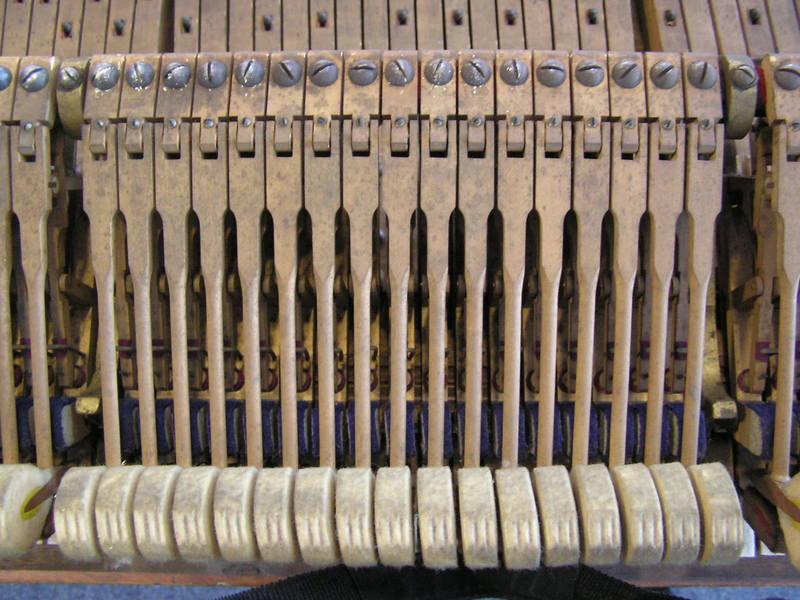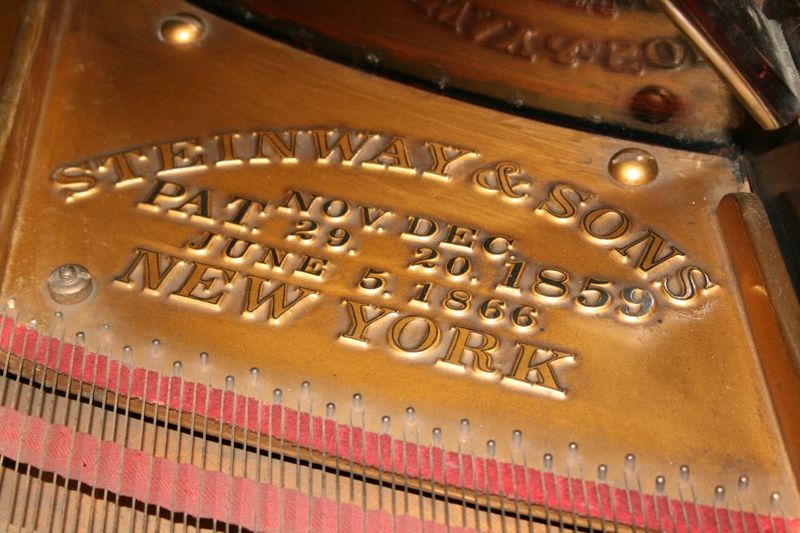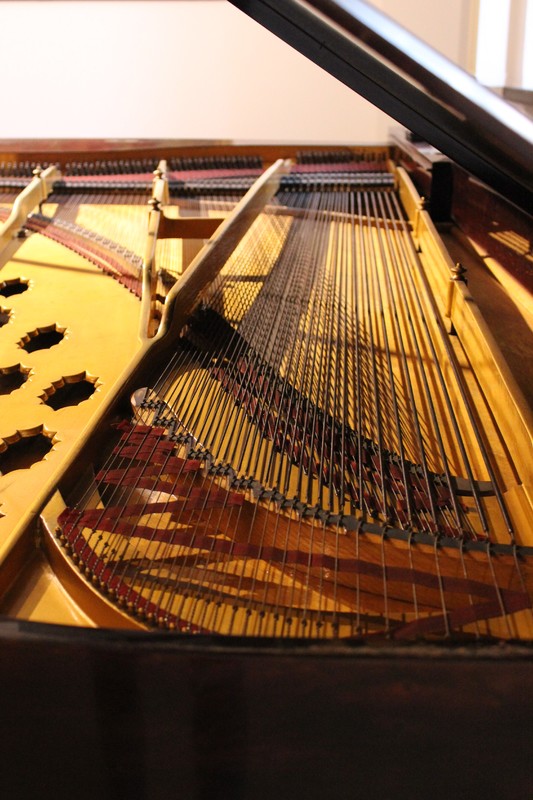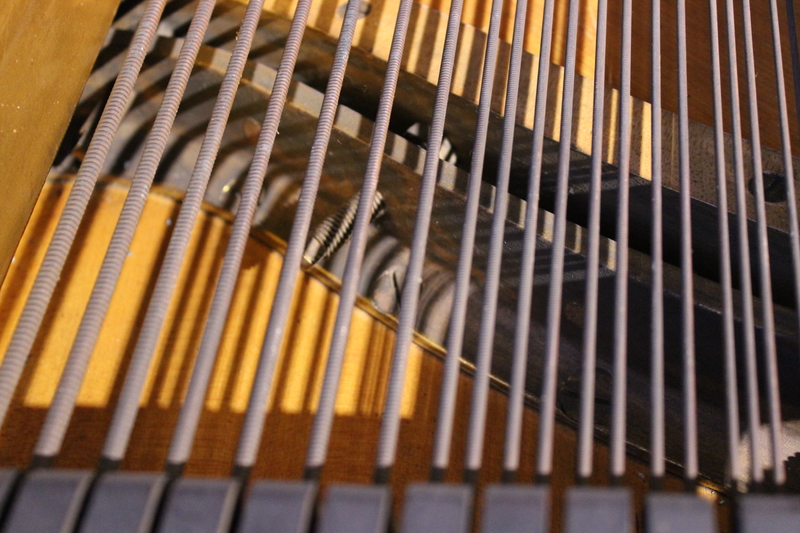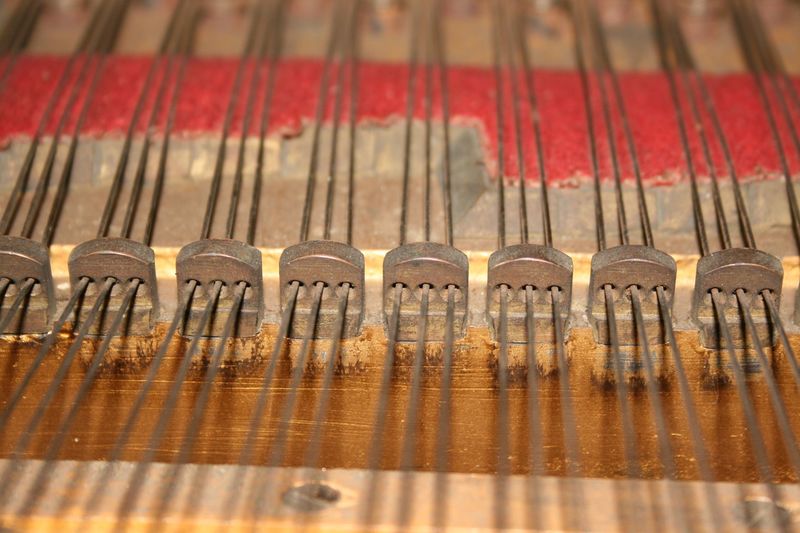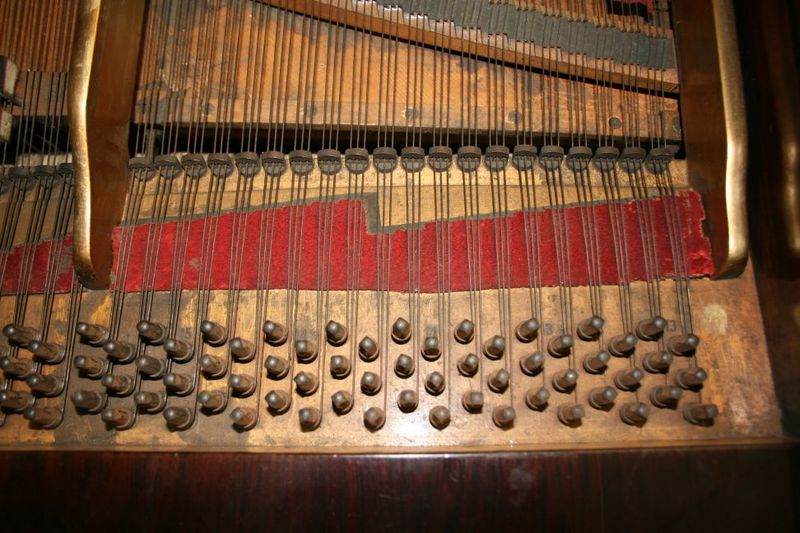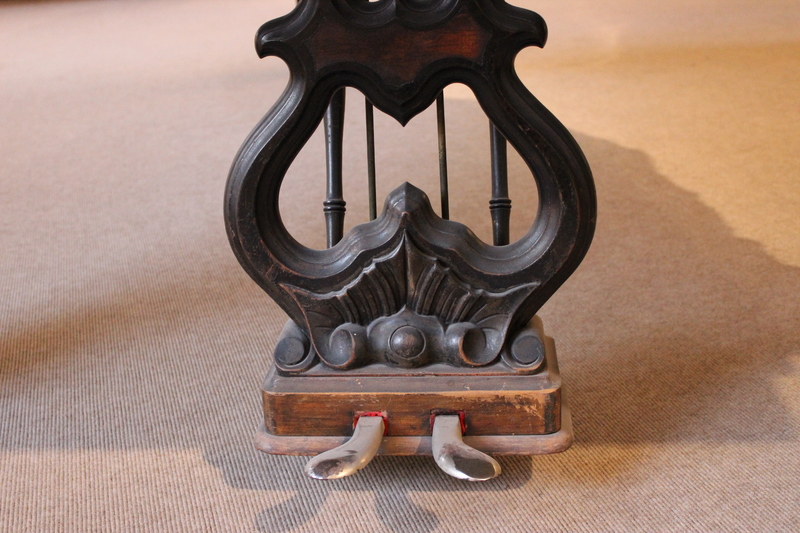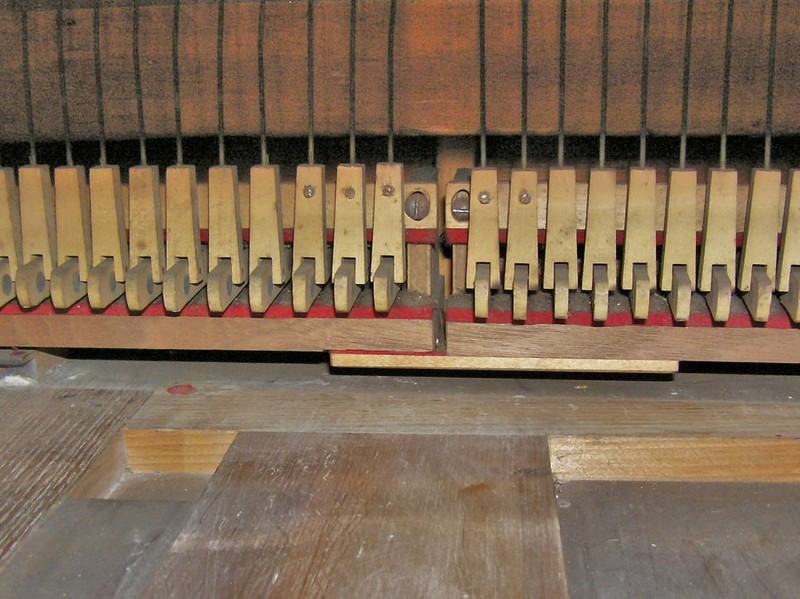Construction
Even pianists are rarely able to explore the construction of their instruments. The veneered case and lid add a decorative touch but conceal the piano’s inner workings. This makes it especially worthwhile to have an unobstructed view of such an instrument from above and below. Although Helmholtz’s Steinway resembles one of the company’s present-day models, it has several structural peculiarities that do not appear later, or only in modified form. Its construction year of 1871 marked the beginning of the phase when the company registered the most patents in its history. Most inventions of that time are still found in every grand piano today – some, however, only in modified form.[1]
At a length of 2.6 m, this instrument is the largest model produced at the time. With its sonority, it can still compete with any concert grand today. Unique to this instrument, however, is that Theodore Steinway, the technical director of the factory, retrofitted it by hand with a new mechanism that was the result of Helmholtz’s acoustic research.
The top view of the grand piano shows many fascinating technical details, which are explained below:

This concert grand already has the modern range of 88 keys, which was still quite unusual in 1871. Steinway chose to give Helmholtz the largest and technically most up-to-date model of the time. Traces on the keyboard and action indicate that the instrument was played a great deal.
In addition to the company logo, the plate also contains the dates of the applications for the three patented constructions found in the instrument: the cross-stringing, the agraffes (vis-à-vis how they are attached to the plate) and the “double iron-frame resonator” – but not the duplex scale, which was installed by hand at a later date.
Since 1859, the bass strings had been strung diagonally across the neighboring strings instead of parallel to them. According to the patent specification, the aim of this change was to achieve longer string lengths and move the bridge closer to the center of the soundboard where it could vibrate more freely than at the edge.
Steinway utilized this unusual construction for only a few years. By adjusting the resonator screws, the soundboard tension could be precisely regulated for optimum vibration.
Link: Patent specification of the “double iron-frame resonator”
In piano construction, agraffes are guide screws with passages that position the strings and prevent them from being deflected upwards when they are struck by the hammer. The agraffe also limits a string’s sounding length. Agraffes have been in use since the early 19th century.
The patent refers to the connection of the agraffe to the plate by a projection (“flange”) on the underside of the plate.
Link: Patent specification of the “plate flange with agraffes”
The duplex scale is the Steinway design that was particularly based on Helmholtz’s acoustic research. However, the patent was not granted until 1872 and thus after the construction of the Helmholtz grand piano. The "Object Biography" menu item explains why it is nevertheless found on this instrument.
The underside of the grand piano also has special features. Here, the rim and beams, soundboard and pedal system can be seen.

The three legs of the grand piano can be easily removed for transportation. They were also removed to photograph the two overall shots. This brought to light the stamp of the Berlin tax office, which is described in the object biography .
One unique feature of the Helmholtz grand may possibly be its special split dampers. Something similar can be found in some earlier historical pianos. The lower and upper half of the range could be separately damped, for example to combine a clearly damped staccato bass with an undamped flowing melody. In this case, the idea is different. Fortunately, Steinway himself offered an explanation in a letter to Helmholtz: The bass strings, now undamped by the pressure of the pedal, are meant to be stimulated by the other struck notes and thus resonate and emit overtones. This “sympathetic resonance” was a popular field of investigation in acoustic research of the times. Helmholtz also dealt with it in detail in his Sensations of Tone.[2]
While the use of split dampers is helpful for composing musical phrases, this variant serves more to enrich the instrumental timbre. The declared intention of “enabling a pleasing resonance to the ear by the harmonic overtones of strings other than those individually struck” is reminiscent of the duplex scale and anticipates elements of its functionality. It is not known whether Steinway used this device on other pianos, however, but it was not patented.
The dampers are visible behind the keyboard. By pressing the right pedal, all dampers are lifted simultaneously by one tray. The special feature of the Helmholtz instrument is that there is no continuous damper tray. The first 17 dampers in the bass are located on their own separate tray. This allows them to be raised independently of the other dampers when the left pedal is pressed.
Early pianos still had a continuous bottom board. From the 1820s on, it was gradually reduced until only those areas remained where the legs and pedals are attached. [3]
In the center, the view of the soundboard with its diagonally running ribs is unobstructed.
In the bass range, where the strings cross, the bridge is separate from the main bridge. The screws on the underside of the soundboard were patented by Theodore Steinway under the name "Acoustic Dowels". They extend through the soundboard into the bridge and serve to support the transmission of vibrations.
Some features in the design of the Helmholtz grand piano date from a transitional phase in piano construction: The outer wall (the so-called "rim") is still composed of several parts, but a few years later it is bent from one piece using a bending press. This gives the instruments overall a rounder shape. The longitudinal and transverse supporting wooden beams ("posts") are later arranged in a radiating pattern. The aim of this is to better connect all components and ensure the most effective vibration transmission possible. Both measures are also intended to lighten the body but maintain its resistance to the high string tension. [4]
[1] For details on the development of the grand piano models and patents see Kehl, Roy F.; Kirkland, David R.: The Official Guide to Steinway Pianos, Milwaukee 2011.
[2] Helmholtz: Sensations, pp. 60-83.
[3] Pollens, Stewart: The Piano of the Future, in: Ziad Kreidy (Hg.): Clefs pour le piano | Keys to the Piano, Château-Gontier 2018 , pp. 397-412.
[4] This paragraph addressed the following patents filed by Theodore Steinway:
- Acoustic Dowels, 1869
- Console Grand Bent Rim Case, Iron Shoe, Radial Braces, 1878
Citation: Katharina Preller, ‘“One of the most beautiful applications of science to art”? The Helmholtz grand piano by Steinway & Sons’, in: Materiality of Musical Instruments. A Virtual Exhibition.

